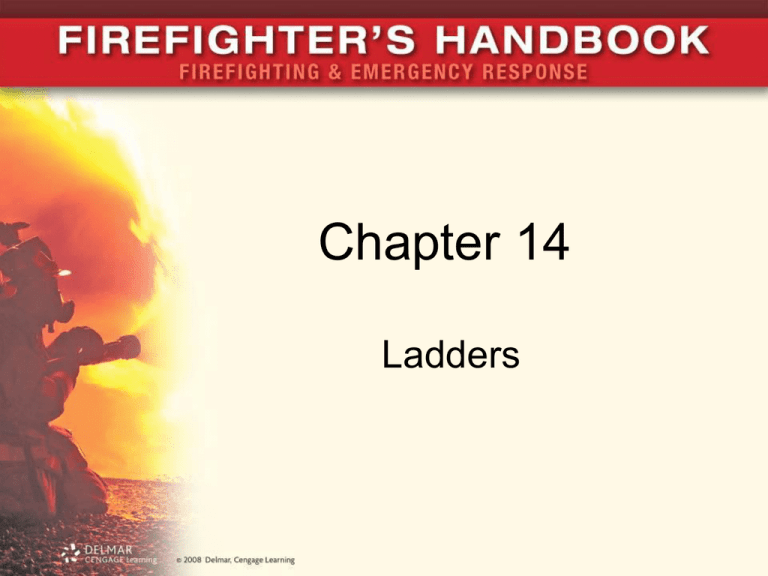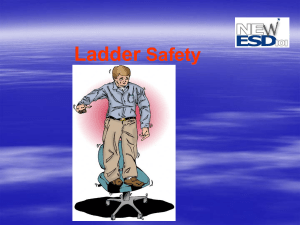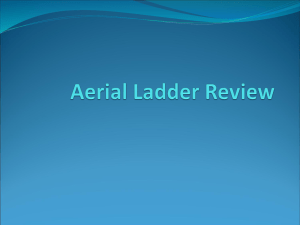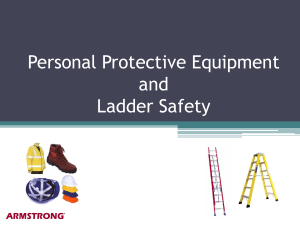Chapter 14
advertisement

Chapter 14 Ladders Introduction • Ladders provide access to elevated or below-grade locations • Truss-type beams have replaced solid wood beams • High-strength aluminum replaced wood • New design technology continued to meet ladder needs • Ladders can be used for many purposes 14.2 Ladder Terminology • Defined as: – “A structure consisting of two long sides crossed by parallel rungs, used to climb up and down” – “A means of ascent and descent” • Many different types of ladders 14.3 Parts of a Ladder • Many parts to a ladder • Different parts of the ladder might have multiple names • Common terminology usage will reduce miscommunication • Glossary of ladder parts on page 417 14.4 (B) (A) (C) Figure 14-1 (A) Straight ladder terminology. (B) Steel spurs on a ladder of truss construction. (C) Swivel shoes with pads and spikes. 14.5 Ladder Companies • Apparatus that carry ladders, devices, tools, and personnel to upper levels • Tower ladders and boom ladders are included in this category • Ladder companies are also responsible for tasks associated with entry 14.6 Grounded (or Portable) Ladders • Complement of ground ladders, sometimes called portable ladders • Common types: – Straight – Extension – Various specialized ladders 14.7 Straight Ladder • Also referred to as wall ladder • Fixed length ladder • Found in lengths between 12 and 20 feet • Generally light • Departments without ladder companies carry ladders on pumping engines 14.8 Figure 14-2 Straight wall ladders. 14.9 Extension Ladder • Consists of two or more ladders • Bed ladder acts as a nest • Fly ladder is movable and slides in channels • Halyard – rope used to extend ladder • Each section locked into place 14.10 Figure 14-4 Extension ladder terminology. 14.11 Roof or Hook Ladder • A straight wall ladder with set of retractable hooks at the tip end • Used on a sloped roof • Can be used as a standard straight wall ladder • Not designed to be used as a hanging ladder 14.12 Figure 14-6 A hook ladder, with retracted hooks, being used as a straight ladder. 14.13 Folding Ladder • Known by many names • Available in lengths from 8 to 16 feet • Provide access to attic spaces • Very portable • Used to remove occupants from elevator car 14.14 (A) (B) Figure 14-7 Folding ladder (also called a suitcase or attic ladder). (A) Folded. (B) Opened. 14.15 A-Frame Combination Ladder • Combination ladder used in various configurations • Acts as a mini-extension ladder • When fully articulated and extended, can be a full fixed straight ladder • Can become a step ladder • Used in tight places 14.16 (A) (B) Figure 14-8 Combination A-frame ladder. (A) Used as a short extension ladder. (B) Being converted from an extension ladder to an A-frame stepladder. 14.17 (C) Figure 14-8 (cont’d.) Combination A-frame ladder. (C) In the A-frame stepladder mode. 14.18 Use and Care • Care must be employed to prevent ladder damage • NFPA Standard 1932 covers use, maintenance, and service testing of ground ladders 14.19 Table 14-1 Ground Ladder Tips 14.20 Maintenance, Cleaning, and Inspection • Ladders should be inspected at regular intervals • Certification label must be affixed • Ladders needing repair are removed from service • Work beyond general maintenance performed by trained technicians 14.21 Table 14-2 General Inspection Guidelines 14.22 Table 14-3 Extension Ladder Inspection Guidelines 14.23 Cleaning Ladders • Dirt and caustic substances act as an abrasive • Warm soapy detergent and scrub brush will remove most dirt • Manufacturer’s recommendations should be consulted 14.24 Ladder Uses • Primarily used for climbing • Used for many purposes: – – – – Shoring tool Fence Hold back loose debris Chute to channel water 14.25 Access • Most obvious use • Provides a path otherwise inaccessible • Can be used to descend into an opening 14.26 Rescue • Extracting a victim • Use of ladders that is employed least often 14.27 Salvage Operations • Used as a tool to support salvage covers • Protect hoselines from falling glass 14.28 Stability • Hook or roof ladder • Provides footing for firefighters on sloped roofs 14.29 Ventilation • Can take place in two ways – Firefighter can use ladder to remove glass with a tool from elevated position – Ladder itself can be used as the tool • Safety must be paramount 14.30 Bridging • Ladder can be an effective bridge between two points • Supports weight over a weakened floor • Bedded extension ladder is safest 14.31 Elevated Streams • Ground ladders are still an option to provide water from an exterior location • Used when no other approach to fire is available 14.32 Elevated Work Position • Serve as exterior work platform • Need to remove something or check for heat during overhauling 14.33 Ladder Selection • Once target is identified, ask these questions: – – – – What length of ladder is necessary? What will be done with the ladder? Will ladder be used at several locations? Is a straight or extension ladder needed? • Some additional considerations: – Ground condition – Accessibility of location – Available personnel 14.34 Butt Section • If ground slopes, raising a ladder might be impossible • 75 degrees is the proper climbing angle • Placed directly under the target • Butt should be carried in the direction of the target 14.35 Fly Section • Tip of fly dictates how ladder will be used • Several specific locations where placement of tip will be important: – Windows – Roof level – Fire escapes 14.36 (A) (B) Figure 14-9 (A) Ladder placed with the tip below the windowsill. (B) Ladder placed with the tip at the top of the windowsill to either side. 14.37 Special Uses • Can be used as tools or as portable stairs • Ladder integrity must not be compromised 14.38 Removal of Numerous Victims • Method: – Raise ladder – Ascend and secure victim onto ladder – Descend escorting victim • For several victims, use two or more ladders • One “supply” ladder can service many escape ladders 14.39 Figure 14-11 Multiple ladder rescue technique. 14.40 Chute with a Tarp • Prevent water damage • Ladder with tarp used as a makeshift chute to direct water out a window Figure 14-12 Ladder with salvage cover, plastic sheet, or tarpaulin used as a chute to divert and discharge water. 14.41 Over a Fence • Two short ladders tied together in an A-frame can be used to climb over fences • There are times a fence cannot be cut Figure 14-13 Ladders can be used to climb over a high fence. 14.42 Elevated Hose Streams • Used in locations that could not be approached conventionally • Basic safety practices must be employed: – Firefighter and hose must be secured to ladder – Ladder must be stabilized at base or tip 14.43 Figure 14-14 A handline can be used off a ground ladder for difficult-to-reach areas. Note the use of a ladder belt. 14.44 Portable Pool • Three or four ladders can be tied together to form a crib and lined with a tarp – Filled with water – Used to capture runoff Figure 14-15 Ladders can be turned into an emergency water pool or collection area. 14.45 Barrier • Tied off to secure dangerous areas • Provides a positive visual deterrent as well as a physical mechanism to prevent passing Figure 14-16 A ladder can be used as a barrier. 14.46 Support • With ropes a ladder can secure objects as an emergency structural stabilizer • Should be replaced as soon as possible with tools designed for the situation Figure 14-17 Ladder used as a shoring tool. A ladder secured to substantial objects by ropes can assist in stabilizing a structural defect as an emergency measure. 14.47 Hoist Point • Set of ladders tied off at tip and at base into an A-frame • Pulley and rope are attached to apex • Ladder weight limits should not be exceeded Figure 14-18 A-frame hoist. 14.48 Ventilation Fan Supports • Short ladder spanning an opening can support a ventilation fan or blower • Innovation must be tempered with safety Figure 14-19 A ladder can be used to support a fan in a doorway. 14.49 Safety • • • • Equated with common sense Use gloves Use correct ladder Overhead wires must be considered “live” • When moving on a ladder, firefighter should keep three limbs in contact 14.50 Overhead Obstructions • Carry injury potential: – Tree limbs, structural overhangs – Television and telephone wires – Overhead electrical lines Figure 14-20 A ladder can make an electrical connection to ground. 14.51 Climbing Path • Imaginary passageway a firefighter climbs through while ascending ladder • Obstructed climbing paths: – Firefighter is required to alter normal climbing angle – Squeeze through a tight space • Breathing apparatus must be considered when estimating space 14.52 Figure 14-21 “Climbing path” pass-through area. 14.53 Ground Considerations • Ladder must be stable, ground must be level • Cannot create a dangerous lateral lean Figure 14-22 Uneven ground effect is magnified as the ladder increases in height. 14.54 Ladder Load • Number of people permitted on ladder at one time will vary • Load capacity based on weight • Recommended maximum load found on label affixed to ladder 14.55 Figure 14-23 Ladders must be positioned properly and not overloaded. 14.56 Working Off a Ladder • Firefighter secured to ladder – Ladder belts – Safety harness – Leg lock Figure 14-25 Leg lock. 14.57 Ladder Storage • Supported by more than two support points • Should be stored on a flat surface • Avoid using the same contact points when storing ladder 14.58 Apparatus Ladder Storage • Should be stored under cover in compartments • De-icing products on ladders during inclement weather 14.59 Ladder Apparatus Parking • Place ladder apparatus at an angle to the fire building • Ladders need to be easily accessible and removed (A) (B) Figure 14-27 (A) It is important to leave room to remove portable ground ladders. (B) Parking apparatus can impede ladder access: parking on an angle can be a simple solution. 14.60 Ladder Painting • Should never be painted as a means of maintenance • Only small areas should be painted: – – – – Identification Visibility Quick reference Hoist points 14.61 Certification and Testing Procedures • NFPA Standard 1931 outlines specific procedures for ladder testing and certification • When ladder model is designed, rigid testing is needed • Ladder label attests that ladder is in compliance with NFPA and OSHA guidelines 14.62 Ladder Skills • Without common terminology and technique, the moving and positioning of ladders can be chaotic • Commands should be established by local department policy • Basic commands relying on common sense should be the norm 14.63 Carrying Ladders • Several techniques used for carrying ladders: – Suitcase carry – Shoulder carry – Flat carry • Single firefighter can carry a small ladder individually • Many types of techniques used when dealing with a victim on a ladder 14.64 Raising Ladders • Several considerations must be weighed: – Heel of ladder must be a calculated distance from building – Ideally, climbing angle should be about 75 degrees • Number of firefighters needed to raise a ladder will vary • Most situations call for two firefighters 14.65 Figure 14-29 The working length is the distance from the ground to the point where the ladder contacts the building. The ladder is placed at a point approximately one-quarter of the working length from the building. 14.66 Rung and Beam Raises • Two methods of raising a ladder: – Two-person rung raise – Two-person beam raise • Raising an extension ladder: – Fly extension raise – Three-person raise • Four-person ladder raise safer than three-person raise – One firefighter should never bring down a ladder 14.67 (A) (B) Figure 14-30 (A) Beam raise. (B) Rung raise. 14.68 Leg Lock • Used to secure firefighter to ladder • Both hands are needed to perform a task • Ladder belt is not available • Second alternate leg lock known as hyper-extended leg lock 14.69 Carrying Tools • When carrying tools, security is sacrificed • Tools should be passed up to another firefighter first • Tools can be hung on an upper rung and climbed to • Tools can ride up the rails of an aerial ladder 14.70 Mounting and Dismounting • Getting on and off a ladder is the most difficult action for the uninitiated – As height increases so does fear of falling – If ladder is not secured by rope, it should be heeled by another firefighter – When climbing into a window from a ladder, two methods are used – Special care should be observed when mounting or dismounting ladder from ornamental works 14.71 Roof and Ladder Deployment • Raised to the eave of the roof directly under desired access point • Hook ladder is raised alongside prepositioned ladder using beam-raise method 14.72 Hoisting Ladders by Rope • Need to use ladder from elevated location might arise – Hoisting ladder by rope • When lowering ladder, procedure is reversed 14.73 Types of Truck-Mounted Ladders • Many types of ladder trucks are used today • Each designed to serve a particular function 14.74 Aerial Ladder • Apparatus-mounted ladder capable of reaching heights of 100 feet • Various sections slide out from one another to produce greater reach • Ladder’s reach achieved through use of cables and pulleys 14.75 Figure 14-38 Aerial ladder raising mechanisms as seen from under a raised bed ladder. 14.76 Figure 14-39 Ladder positioning terminology. 14.77 Tower Ladder • Standard piece of equipment in moderate to large departments • Telescopic boom with mounted basket • Affords people who suffer from a fear of heights • Takes slightly longer to place into operation 14.78 Figure 14-41 Tower ladder. 14.79 Articulating Boom Ladder • Also called snorkel ladder • Among the first designs for elevated platform use • Uses several articulating booms • Can also be used as an elevated water application platform or observation point 14.80 Figure 14-42 A snorkel basket can reach places not possible with other types of apparatus. 14.81 Lessons Learned • Ladders have many applications • Different types of ladders are designed for a specific use • Ladder use is packed with additional dangers that each firefighter must respect 14.82







